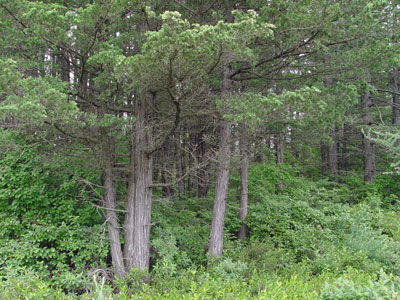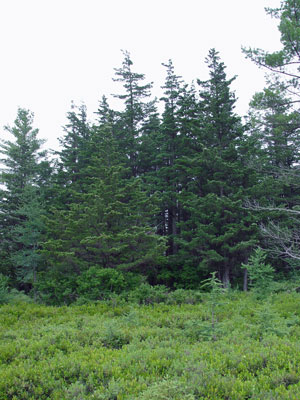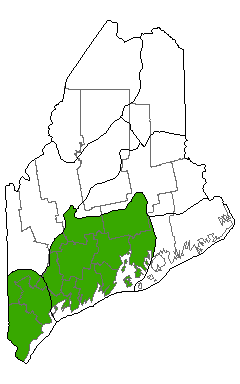DACF Home → Bureaus & Programs → Maine Natural Areas Program → Communities, Plants, and Animals → Natural Community Fact Sheets → Atlantic White Cedar Bog
Printer Friendly Fact Sheet - 1.3 MB pdf (Get a free copy of Adobe Acrobat Reader)
Atlantic White Cedar Bog
Scientific Name: Atlantic White Cedar Bog; State Rank: S1

- Community Description
- Soil and Site Characteristics
- Diagnostics
- Similar Types
- Conservation, Wildlife and Management Considerations
- Distribution
- Characteristic Plants
- Associated Rare Plants
- Associated Rare Animals
- Examples on Conservation Lands You Can Visit
Community Description: These peatlands are dominated by dwarf heath shrubs with a sparse tree layer of Atlantic white cedar. Sheep laurel, Labrador tea, dwarf huckleberry, and other heath shrubs can form an almost continuous carpet beneath the stunted cedars. Leatherleaf is a common shrub. Herbs are sparse. The bryoid layer is well developed with peat moss covering the ground and forming the substrate. Back to top.

Soil and Site Characteristics: Sites occur in basin wetlands of the southwestern coast, usually in areas transitional between fen and bog. They generally maintain contact with the groundwater but lack indicators of minerotrophic conditions. Peat and water are highly acidic. Back to top.
Diagnostics: These peatlands possess abundant low heath shrubs and peat moss and are only sparsely forested by Atlantic white cedar. Back to top.
Similar Types: Atlantic White Cedar Swamps occur on mineral soil or on thin peat (< 30 cm) over mineral soil and typically have higher canopy closure (> 50%). Other sparsely forested bog or fen communities, such as Dwarf Shrub Bog and Leatherleaf Bog, can have similar composition in the dwarf shrub, herb, and bryophyte layers, but lack Atlantic white cedar. Back to top.
Conservation, Wildlife and Management Considerations: These bogs occur as part of larger peatlands, and maintaining the hydrologic integrity of the entire wetland with upland buffers is key. The cedars generally remain small, and therefore are of limited economic value. Most known sites in Maine are in conservation ownership. Frequent birds associated with this community include common yellowthroat and northern waterthrush. These wetlands provide habitat for the rare Hessel's hairstreak butterfly, which feeds on Atlantic white cedar in its larval stage. Back to top.
Distribution: Eastern Broadleaf Forest Province, extending southward from Maine. Landscape Pattern: Small Patch. Back to top.


Characteristic Plants: These plants are frequently found in this community type. Those with an asterisk are often diagnostic of this community.
- Canopy
- Atlantic white cedar*
- Black spruce*
- White pine
- Sapling/Shrub
- Atlantic white cedar*
- Black huckleberry
- Mountain holly
- Dwarf Shrub
- Dwarf huckleberry*
- Labrador tea*
- Large cranberry
- Leatherleaf*
- Sheep laurel*
- Herb
- Pitcher plant
- Tufted cotton-grass
- Bryoid
- Dicranum moss
- Reindeer lichen
- Sphagnum mosses*
- Hessel's hairstreak
Examples on Conservation Lands You Can Visit
| Example | County |
|---|---|
| Knight Pond, St. Clair Preserve | Waldo Co. |
| Saco Heath Preserve | York Co. |